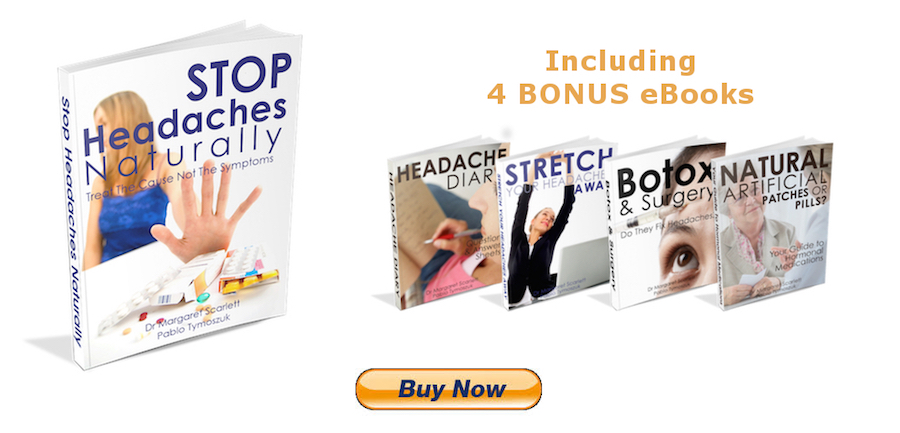3 Reasons You Have Headache Pain
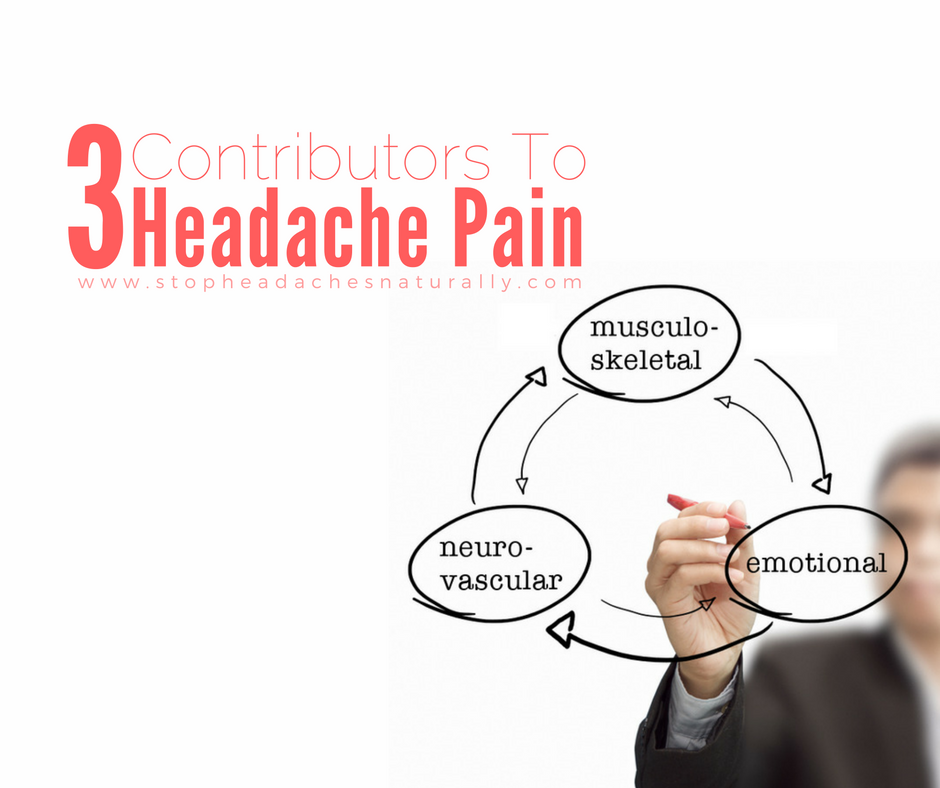
When we started writing this book our focus was on headaches provoked by musculoskeletal problems, and especially by muscular trigger points. However many other factors unrelated to musculoskeletal problems are known to provoke headache attacks, including tiredness, dehydration, certain foods, changes in female hormone levels and flashing lights, to name but a few.
We wanted this book to be useful to as wide range of headache sufferers as possible, so we decided to increase its scope to cover such cases. However we then faced the problem of how to unify all of this information.
From our research we came up with a simple model based on the nature of headache pain. In this model, headache pain arises from a combination of 3 separate contributions:
1. A musculoskeletal contribution – due to problems with muscles and joints
2. A neurovascular contribution – due to changes in nerve activity and blood flow in parts of the brain
3. An emotional stress contribution – this acts like a pain volume control
Reducing any one of these contributions lessens the pain you feel. It may even lessen it sufficiently to prevent a headache from occurring in the first place.
"Reducing any one of these contributions lessens the pain you feel."
There are a number of natural methods available to reduce each of these contributions. For example, the contribution to headache pain from musculoskeletal problems can be readily treated by manual therapy, together with correction of posture, stretching and strengthening of postural muscles.
Emotional stress can be treated by a variety of techniques including relaxation, biofeedback and altering negative thought patterns. The neurovascular contribution can be reduced by making changes to your lifestyle, environment and diet and by reducing emotional stress.
These techniques and more are covered in this book.
This is an excerpt from the ebook Stop Headaches Naturally - Introduction: A Model For Headache Pain
Painkilllers Just Mask The Pain
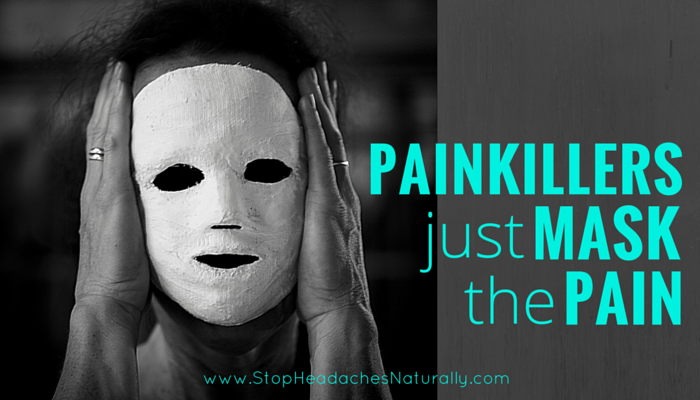
Frequent headaches can really reduce your quality of life but pain-killers are not the answer
Pain of any sort isn't any fun, but headache pain can stop you thinking clearly. Even a relatively mild headache makes it more difficult to do your work properly and just getting through your daily routine starts to become an effort.
But a severe headache can stop you dead in your tracks and render you unable to function normally. And if the pain is accompanied by typical migraine symptoms of nausea and vomiting then probably all you will be able to manage to do is to go home and collapse into bed.
"It is tempting just to reach for a pain-killer to numb the pain"
What makes it harder is that you often don’t get much sympathy or understanding from those around you, unless they are also badly affected by headaches. Because headaches are extremely common they may be seen as “normal” and not a “proper illness”.
Even our language tends to trivialize headache pain as in the expression “a real headache” for some annoying or difficult problem.
"A headache may be seen as an excuse to avoid responsibility or something you don’t feel like doing"
And a headache may be seen as an excuse to avoid responsibility or something you don’t feel like doing, as in the well-worn cliché “Not tonight dear, I have a headache” for avoiding sex in a relationship.
If you suffer lots of headaches, and particularly if they are severe, it is easy to feel helpless not knowing when a headache will strike again or how to stop it from returning. Headaches can appear in the day or the dead of night.
One time, a headache might hit during a stressful crunch to meet deadlines at work, another may occur in the middle of an uneventful day, and yet another during a pleasurable activity.
The cause of your headaches can look like a complete mystery.
"Makes you an easy target for shrewd marketing campaigns by the pharmaceutical industry with their TV commercials promising “a quick fix” for your headache pain"
All of this makes you an easy target for shrewd marketing campaigns by the pharmaceutical industry with their TV commercials promising “a quick fix” for your headache pain.
It is tempting just to reach for a pain-killer to numb the pain.
While this is understandable and OK every now and then, it is most definitely not a good idea on a long term basis for the following reasons:
- You are only masking the symptoms, not treating the underlying factors that are provoking your headache. Only by understanding and correcting these factors can you can ever hope to be free of headache pain.
- You are actually likely to make your headaches much worse. Instead of occurring perhaps several times a month, they now occur much more frequently, often daily, and the pain is more severe and longer-lasting. This is known as rebound headache or medication overuse headache.
- All medications have side effects. Serious side effects of long-term use of headache painkillers include damage to the gastrointestinal tract, liver and kidneys.
- By relying on a pill, you perpetuate your feeling of helplessness. It seems like headaches are controlling your life and there is nothing you can do about it. If you unravel the factors that are provoking your headaches, you will restore your feeling of being in control of your life, and this may go some of the way towards actually alleviating your headaches.
There are genuine natural alternatives to pain-killers
It is easy to find detailed information about headache medications on the internet. However information about natural therapies for headache is normally presented in a scatter gun fashion in the form of a list of things to try.
That is why we wrote the book Stop Headaches Naturally - Treat The Cause Not Symptoms. The main aim of this book is to provide you with comprehensive, reliable information about the different types of natural therapies which are available for headaches. We have also tried for to organise this information in a way which makes it easier for you to access and apply.
Photo credit: wolfgangfoto / Foter.com / CC BY-ND
Why Does Stress Plus Muscle Tension Equal Headache?
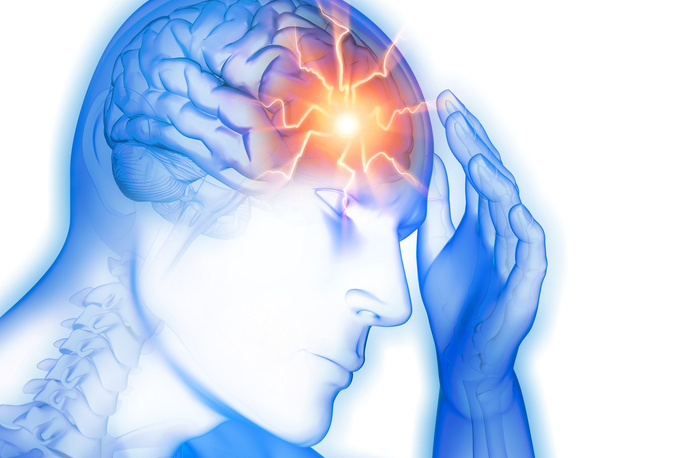
Both migraine and tension headache sufferers list emotional stress, and feelings such as anxiety, worry, fear, anger, and frustration that accompany it, as their most important trigger. But emotional stress is more than a trigger. It is part of the mechanism that produces a headache.
Emotional stress can contribute to headaches by:
- Interfering with natural pain suppression mechanisms
- Increasing the excitability of the brain
- Altering bloodflow to and within the brain
- Causing the release of histamine, a vasodilator and inflammatory substance
- Increasing musculoskeletal pain
On-going stress can lower your headache threshold, making it more likely that exposure to your other triggers will provoke a headache attack. Specific short term stressful episodes may trigger a headache attack. [12]
The role of emotional stress in provoking headaches is reasonably well appreciated. However few headache sufferers are aware that the sustained and excessive amounts of muscle tension may play an equally important role.
Nor are they usually aware of just how tight the muscles in their jaw, neck and shoulders actually are for most of the time. Sustained tension in these muscles is a common response to emotional stress.
It is also the result of maintaining the upper part of your body in a fixed posture. Sitting without moving for lengthy periods of time is a major culprit. Sitting with your neck craned forwards magnifies the problem. This “forward head posture” [13] will also cause pain in the joints of your neck.
Tight or tense muscles are muscles that are actively contracting. However, as we have seen, when muscles stay contracted for too long without relaxing they start to suffer microscopic tissue damage. Various inflammatory substances are released into the muscle fluid from where they are transported into the blood stream.
"when muscles stay contracted for too long without relaxing
they start to suffer microscopic tissue damage"
Hence on-going tension in neck, jaw and shoulders acts as a continual low level source of pain which can reduce your headache threshold. If trigger points are present, tension may irritate them sufficiently to provoke a headache attack.
Muscle tension, like emotional stress, lowers your headache threshold, making a headache attack more likely. Muscle tension can also act as a headache trigger.
[12] JM. Nash and RW Thebarge (2006). “Understanding Psychological Stress, Its Biological Processes, and Impact on Primary Headache.” Headache 46(9):1377- 1386.
[13] DG Borenstein, SW Wiesel and SD Boden (2004). Low back and neck pain: comprehensive diagnosis and management, p231-233, Edition 3, Elsevier.
How To Be A Smart Smartphone User

If you use a smartphone or tablet for more than one hour everyday, you definitely need to learn how to use it more intelligently… and no, i am not referring to another new app that will help you streamline your workflow.
The exponential growth in mobile technology has made it possible for people from all walks of life, young and old to own a mobile device. People not only using mobile devices for texting or phone calls but to read emails and eBooks, interact within social-media circles, play games and watch videos. This forces them to hold their necks in a bent position for long periods, creating excessive strain on the ligaments, tendons and muscles of the cervical vertebrae.
Unfortunately many of us ignore the aches and pains that occur while using our mobile devices, but it is only a matter of time before we begin to experience more serious problems like:
• Tension headaches
• Blurred vision
• TMJ syndrome (jaw pain)
• Joint pain
• Muscular tension and stiffness in the neck, shoulders and back
• Tingling down the arm and fingers
What is the real cause behind the neck pain
Your neck is at its most relaxed and comfortable state when the weight of your head is positioned directly on top of your spine. The muscles around the front, back and side of your neck should be working together to hold your head in a neutral position – looking straight ahead - this is the most natural state or position of the neck. So when you use a mobile device for prolonged periods with a bent and rotated neck, this will create an unnatural position, which leads to overuse injuries.
Of course, bending and turning your neck in various directions is encouraged because the cervical vertebrae are designed to facilitate free movement in all directions. However, you must be aware of your posture and make sure that your neck does not remain in awkward positions for long periods and returns to the neutral position.
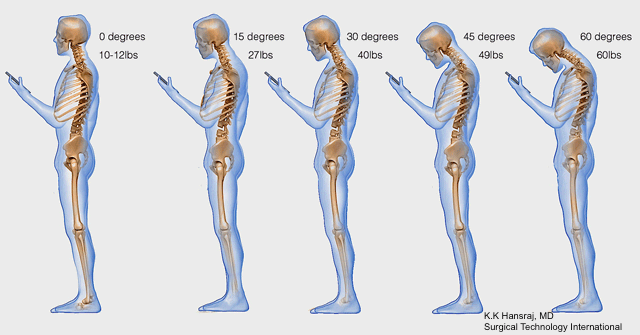
On average, people use mobile devices for two to four hours a day. In other words, our necks are bent and held in a forward head position for 700 to 1,400 hours every year. It is the cumulative effect of years of overuse and stress that leads to degeneration and serious neck and back problems.
How to minimize the damage
Dr. Ezriel Kornel, a neurosurgeon from New York has offered some suggestions for computer and mobile users to reduce the damage caused by poor posture:
• Keep your phone or tablet at a higher level so you are not continually bending your head forward
• The Alexander technique is beneficial as it helps you become aware of how you use your body and teaches you optimal body positioning and poise
• If you suffer from neck pain or headaches, use mobiles phones in moderation to help reduce excessive strain on the neck
• Take frequent breaks. Stretch your neck and reposition your body to relieve the accumulated tension (using an app to remind you can be very useful)
Whether you like it or not, using a mobile device has become a part of our daily lives and it is here it to stay. So it is important that you are aware of the negative effects of prolonged mobile use, especially with your neck bent forwards. Not only will it improve your posture but it will also decrease your stress levels, reduce muscular aches and pains and be one the keys to stopping your headache and migraine pain… you will have become a smart smartphone user.
________________________
Pablo Tymoszuk is a soft tissue therapist specialising in remedial, myofascial and dry needling techniques. He also acts as an ergonomic specialist and wellness consultant which has motivated him to co-author the eBook Stop Headaches Naturally.
Together with Dr Margaret Scarlett they present a range of strategies for stopping headaches and migraines without drugs. All strategies are organized in a systematic manner and backed up by references to the scientific literature.
Laughter Better Than Medicine And Affects The Body Like Exercise
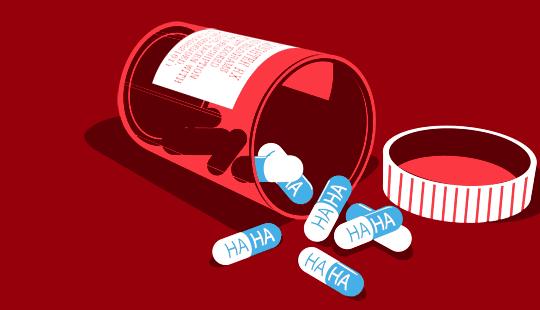
After a real belly laugh and wiping the tears from my eyes, there is no doubt to me that my mind and body are better for it... even though my ribs hurt, it's as if a weight has been lifted off my shoulders.
I have always believed that laughter is as good as medicine. So when I came across this article by dailyhealthpost.com regarding 'mirthful laughter' [*] and it's health benefits, I was interested. I trust that you find it as interesting as I did.
[*] Mirthful: full of or showing high-spirited merriment
Enjoy the read...
We are rife with involuntary reactions. We know why we sneeze. We know why we cough. We know why we blink our eyes. But we don't really know why we laugh.
Sense of humour is personal but everyone has one. We weren't built with extraneous physiological processes, everything our bodies do has a purpose. So while we may not know why we laugh, we now know that doing so contributes to physical and emotional health.
In the 1970s, Norman Cousins, editor of the Saturday Review, published his story of laughter as medicine in The New England Journal of Medicine. He subsequently published books on the subject of mind-body healing: Anatomy of an Illness, Head First, and Mind Over Illness. In these, he explores his experience of having been diagnosed with life-threatening heart disease in 1964 for which he had self-treated with massive doses of vitamin C and laughter. [1] (Cousins died in 1990). His story spurred scientific research into the psychology of laughter - gelotology. Many studies have now shown that laughter does, in fact , promote wellness.
The results are complex and fascinating.
Laughter appears to occur more frequently and has a greater physical impact when it occurs in a group setting. laughing alone is good but laughing with others is even better. The physical act of laughing causes the release of endorphins-neurotransmitters that moderate pain and stress with an opiate effect.
In a controlled study, pain threshold was significantly higher after laughter than without. [2] Even anticipation of the prospect of "mirthful laughter" reduces stress hormone levels and increases endorphins and human growth hormone (which contributes to optimizing immunity).
A study of high-risk diabetics found that:
“the addition of an adjunct therapeutic mirthful laughter Rx (a potential modulator of positive mood state) to standard diabetes care may lower stress and inflammatory response and increase 'good' cholesterol levels. The authors conclude that mirthful laughter may thus lower the risk of cardiovascular disease associated with diabetes mellitus and metabolic syndrome.” [3]
The benefits of laughter don't stop there.
The physical act of laughter - not just a chuckle, but real, belly-type laughter - is exercise. If you've ever had one of those episodes (and we certainly hope that you have) in which you laugh so hard that you cry and can't breathe, you know that you could be a little sore afterward. Without thinking, the act of laughing promotes various physical activities:
1. Laughter dilates blood vessels, improving circulation, and exercises abdominal, facial and other muscle groups.
2. The release of growth hormones and dopamine in the brain bring a sense of euphoria and happiness - a high that improves not only mood but supports immune function.
3. With the release of hormones and neurotransmitters during and following a bout of laughter, blood sugar and cholesterol levels are reduced. These effects can last for days, especially if laughter is a regular part of your life.
4. With the highs comes the lows - in a good way: improved blood flow and body nourishment, the reduction of stress and pain, and emotional contentment are followed by greater relaxation and better sleep quality.
Science was loth to investigate the phenomenon of laughter until fairly recently. Unlike other involuntary response, it seemed... click here to read the rest of this article.
Source [1] [2] [3]
Pablo Tymoszuk is a soft tissue therapist specialising in remedial, myofascial and dry needling techniques. He also acts as an ergonomic specialist and wellness consultant which has motivated him to co-author the eBook Stop Headaches Naturally.
Together with Dr Margaret Scarlett they present a range of strategies for stopping headaches and migraines without drugs. All strategies are organized in a systematic manner and backed up by references to the scientific literature.
You’ve Been Drinking Coffee at the Wrong Time and Here’s Why
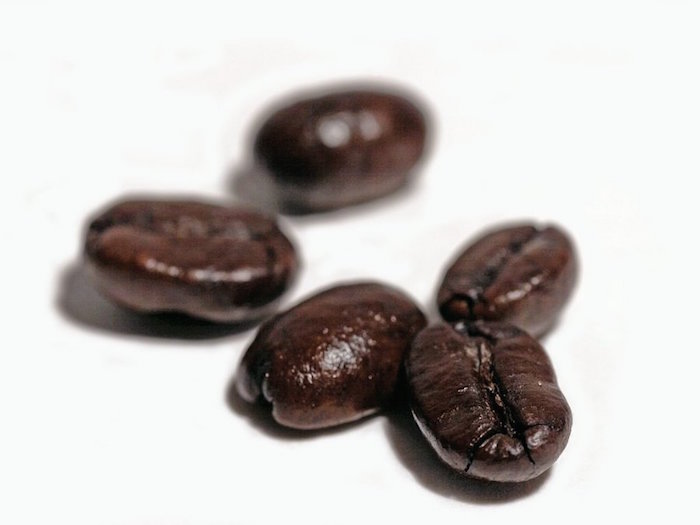
Life is too short for bad coffee and I have to admit that I have become a coffee snob. So when I enjoy my daily espresso (hard core, I know), it certainly needs to be good!
Even though coffee has numerous health benefits, it is important to limit its intake, especially if you suffer with headache and migraine pain. For that reason the following article by Daily Health Post [1] caught my attention... when is the best time of the day to enjoy my perfectly roasted and freshly ground coffee bean from Costa Rica... that has a sweet cherry aroma and leaves a creamy mouth feel with a crisp red apple finish?
Enjoy the read...
Americans LOVE their coffee (I would say Australians LOVE their coffee as much, if not more than Americans). It's estimated that eighty percent of all adults drink caffeine on a daily basis and of those, over half are taking it in coffee.
Coffee has been studied probably more than other beverage in recent years and the majority of conclusions are positive. Decidedly so.
A healthy stimulant
Coffee improves memory, combats diabetes, contains antioxidants, and of course, increases our energy. Most people don't realize that coffee reduces the risk of liver, oral, and skin cancers, and neurodegenerative disease:
"The findings of the previous studies are somewhat inconsistent, but most studies (3 out of 5) support coffee's favorable effects against cognitive decline, dementia or AD. In addition, two studies had combined coffee and tea drinking and indicated some positive effects on cognitive functioning. For tea drinking, protective effects against cognitive decline/dementia are still less evident. In the CAIDE (current) study, coffee drinking of 3-5 cups per day at midlife was associated with a decreased risk of dementia/AD by about 65% at late-life." [2]
People drink coffee because it tastes good and provides a legal buzz that makes the morning zip by.
Get the most zip from your cuppa

If you want to get the most of your (first) morning coffee, you may want to wait a little bit before you drink it. When you wake up, a hormone called cortisol - the 'stress hormone' - that's created by the adrenal glands kicks into gear to get all your systems functioning. You naturally get an energy boost.
By drinking caffeine first thing, you feed your energy level when it's already revving up. If you wait ninety minutes to a couple of hours after you get up, your timing will be jibe with your body's natural energy flow and turn it up just as it starts to flag.
If you wake up at 7:00, let's say, waiting at least 8:30 before you drink any caffeinated beverage will get the most out of ot, energy wise. Caffeine works by blocking energy regulators called adenosine that tell your body you're becoming fatigued.
Adenosine builds up during the day as you expend energy until melatonin is released as it gets dark outside to tell your body it's getting time to wind down and go to sleep. By blocking adeosine, your brain doesn't feel tired. Zippa-dee-doo-dah!
There's a time for everything
The best time for caffeine is then mid-morning, between when you awaken and when you eat lunch to keep energy levels even. If you drink an afternoon cup, too, the same reasoning holds: about half-way between lunch and dinner. Watch that second cup, however: studies have shown that drinking coffee less than 6 hours before bed can interfere with your sleep.
Given our love of caffeine, there are some downsides to drinking it regularly: it can affect our sleep, is addictive, can cause headaches and affect moods.
It’s all about moderation.
sources:[1] [2]
Pablo Tymoszuk is a soft tissue therapist specialising in remedial, myofascial and dry needling techniques. He also acts as an ergonomic specialist and wellness consultant which has motivated him to co-author the eBook Stop Headaches Naturally.
Together with Dr Margaret Scarlett they present a range of strategies for stopping headaches and migraines without drugs. All strategies are organized in a systematic manner and backed up by references to the scientific literature.
Smartphones Are A Hazard For Posture

Our smartphone obsession is putting Australians at risk of becoming a nation of hunch-backs, experts fear.
Chiropractors and physiotherapists are reporting a marked increase in the number of patients being treated for neck and shoulder complaints due to smartphone use.
Arthritis and Osteoporosis Victoria forecasts cases of arthritis and other musculoskeletal conditions will almost double to 8.7 million Australians within 20 years, with health costs estimated to be around $4.8 billion a year.
Australian Chiropractor Association spokesman Dr Michael Black said patients were experiencing headaches, upper back pain, sprains and muscle spasms. “While many people are tablets it appears that their ‘normal’ postural positioning has transformed people to developing rounded shoulders and subsequent forward head carriage leading to upper neck and upper back pain, resulting,” in headaches or migraines.”
Herald Sun | Richard Noone
Are suffering with headaches, back pain and spasms?
Do you need some help improving your posture?
Then have a look at just a few sections of Chapter 8 in the book Stop Headaches Naturally
IMPROVE POSTURE
- 8.2 What does having good spinal posture mean?
- 8.4 The wall test to assess and improve spinal posture
- 8.6 Modern work and leisure sets us up for bad posture
- 8.7 Mobile electronic devices and forward head posture
- 8.9 Set up your computer to minimize postural stress
CORRECT BREATHING
- 8.18 Diaphragmatic breathing & headache prevention
- 8.19 Learn how to breathe using your diaphragm
RETRAIN CORE MUSCLES
- 8.20 Spinal posture and the core postural muscles
DO SPECIFIC EXERCISES
- 8.21 Why exercises are important for headache prevention
- 8.23 Two part exercise for correcting forward head posture
Pablo Tymoszuk is a soft tissue therapist specialising in remedial, myofascial and dry needling techniques. He also acts as an ergonomic specialist and wellness consultant which has motivated him to co-author the eBook Stop Headaches Naturally.
Together with Dr Margaret Scarlett they present a range of strategies for stopping headaches and migraines without drugs. All strategies are organized in a sy
Anger Is A Health Hazard

Anger is a conundrum of complexities that affect each and every person differently. Are you a road-rager? A passive aggressive? Short fused?
Anger is a normal human emotion that is rarely a pretty one; it can be downright embarrassing, dangerous, with significant negative affects on the human body.
There is a flipside to negative anger, when managed well it can be: a healthy release, a motivator for change or a self-empowering tool.
The spectrum of anger ranges from mild frustration and annoyance to out of control rage; affecting your emotional, physical and cerebral state. The part of the brain that responds first when anger strikes is the amygdala. You can find it located deep within the temporal lobe of the brain.
The amygdala controls emotion and the instinctive ‘fight or flight’ response to fear, feeling threatened and stress. It is able to process a magnitude of information, assessing the possible dangers within milliseconds; allowing you to react first and think later.
Above the amygdala within the frontal lobe lies the ability to make decisions, solve problems and behavior. When anger hits, blood rushes through the frontal cortex clouding rational thought; depending on the person, this flash reaction can be either helpful or harmful. The old adage of ‘count to ten before reacting’ comes in handy here.
The domino effect of anger continues with the adrenal glands saturating the system with the stress hormones adrenaline and cortisol, giving you a burst of energy and added strength. This redirects blood flowing to the stomach and intestines to the muscles instead, in preparation to fight. Your blood pressure, pain threshold and temperature raise, breathing and heart rate increase, the pupils begin to dilate.
All the above happens each time anger or frustration get the best of you. How many times a day do you yell at the person who cut you off or the automated service that will not redirect you or your significant other? Anger not only affects the people around you, it is also is directly linked to your cardiovascular health and mental well-being.
According to Heart MD, “Higher levels of fatty acids and blood sugar are released to provide immediate energy to survive the perceived emergency.” The problem with the continued release of these fatty acids is overtime they start to build up in the arteries, setting you on a path towards heart disease. If you are someone who is constantly battling with anger, you are putting your health at a much higher risk for coronary heart disease or heart attack.
If you are an angeraholic, another issue you need to consider is the direct result of daily anger damaging the brain. Researchers have found that a continued supply of ‘trigger and effect anger’ may confuse the hippocampus (stress responder in the brain) and result in the inability to suppress your anger response all together.
There have also been studies showing anger in the brain disrupts the growth of new neurons, essential to sending messages and communicating with the rest of the body.
Some known health problems associated with anger include:
• Depression
• Anxiety
• Sleeplessness
• High Blood Pressure
• Risk of Coronary Disease
• Skin problems like increased acne
• Headaches or Migraines
• Digestive irregularities
Anger Management Tips
If you are a hothead who cares about your health, who cares about prolonging your future, anger management is right up your alley. Keep in mind that adopting and replacing a bad habit with a new one takes practice and doesn’t practice make perfect?
Try these anger management tips suggested by the Mayo Clinic:
• Think before you speak
• Let your mind clear before expressing your thoughts so you can think clearly
• Exercise to work off the frustration
• Walk away and Take a Timeout before you say or do something you might regret
• Refocus your anger to finding solutions instead of concentrating on the problem
• Stick with ‘I’ statements when expressing your feelings, so the discussion does not become about who’s fault it is instead of the real issues
• Learn to forgive
• Laugh Laugh Laugh. Even at the height of an argument, if you force yourself to take a moment and start laughing, your mood immediately changes
• Learn relaxation skills that are most beneficial to you in most situations: breathing slowly as you concentrate on your breath, yoga, write your feelings down in a journal, look in a mirror and remind yourself to calm down and relax over and over again until you start to feel calmer
• Realize when anger management tips are not enough and seeking help would be more beneficial
• Don’t let anger take you over, ruining the important things in your life that mean the most. Prolonged manifestations of anger are detrimental to the heart and the brain. Learning to convert anger into a positive experience will make your life a happier place
Source
Pablo Tymoszuk is a soft tissue therapist specialising in remedial, myofascial and dry needling techniques. He also acts as an ergonomic specialist and wellness consultant which has motivated him to co-author the eBook Stop Headaches Naturally.
Together with Dr Margaret Scarlett they present a range of strategies for stopping headaches and migraines without drugs. All strategies are organized in a systematic manner and backed up by references to the scientific literature.
Can A Smoothie Help Reduce Inflammation?
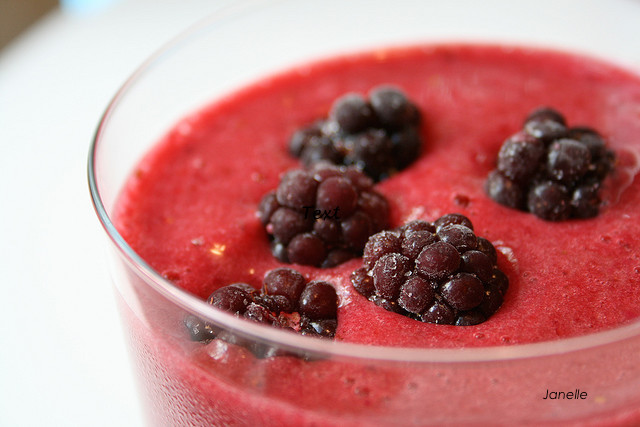
Chronic inflammation in the body leads to advanced aging and disease. It can be caused by many different factors including diet, allergy, stress, or injury. Determining cause allows us to take steps to manage or eliminate the problem and the foods we eat are key in treating any physical condition, including inflammation.
There are some foods that we know cause inflammation in the body: sugars, trans fat, dairy, alcohol, and chemicals in food, among others. We can avoid them if we know what they are.
If you are concerned about inflammation, whether you are feeling its effects or just want to support your immune system, here is a delicious smoothie to do that.
Let’s Review The Ingredients
Berries contain antioxidant phytonutrients called flavonoids (specifically, anthocyanin) in their skins that exhibit anti-inflammatory properties. They are the pigment that give berries their color.
Dark leafy greens are full of nutrients: vitamins, minerals, and antioxidants that support every system in your body. Magnesium in particular is important for inflammation regulation and kale, spinach, beet greens, okra, and broccoli are especially rich in this mineral.
Ginger is a magical plant. It aids digestion, prevents cancer, eases arthritis pain, and inhibits the formation of arterial plaque through its anti-inflammatory phytochemical gingerol.[1]
Coconut oil is a healthy, nutrient-rich saturated fat that has a positive influence on your body, specifically:
“The anti-inflammatory, analgesic, and antipyretic effects of VCO [virgin coconut oil] were assessed. In acute inflammatory models, VCO showed moderate anti-inflammatory effects on ethyl phenylpropiolate-induced ear edema in rats, and carrageenin-[sic] and arachidonic acid-induced paw edema. VCO exhibited an inhibitory effect on chronic inflammation by reducing the transudative weight, granuloma formation, and serum alkaline phosphatase activity. VCO also showed a moderate analgesic effect on the acetic acid-induced writhing response as well as an antipyretic effect in yeast-induced hyperthermia.”[2]
Chia seeds are high in omega-3 fatty acids (with eight times more than salmon!) which are critical for cell health. These building blocks reduce inflammation, thereby decreasing the risk for cardiovascular and neurodegenerative disease.[3] Flax seeds and walnuts are good substitutions.
Green tea contains antioxidants that reduce inflammation and may inhibit tumor growth. Black tea also reduces inflammation in the body but green tea somewhat more so, probably due to its higher flavonoid content.[4] Green tea has less caffeine than black tea; the level can range from 10-22mg per eight-ounce cup. This is in contrast to black tea which contains 22-28mg of caffeine. (The longer it steeps, the more caffeine is released.)
The Anti-inflammatory Smoothie
Ingredients:
• 1 cup berries of your choice (blueberries, raspberries, cranberries, blackberries, strawberries)
• 1 cup leafy greens of your choice (kale, spinach, beet greens), compressed
• 2-inch (5 cm) piece of ginger
• 1 tablespoon unrefined organic coconut oil
• 1 teaspoon (or more, to taste) of fresh chia seeds
• Green tea, steeped to desired strength
• Honey, maple syrup, or stevia to taste to sweeten, if desired
Directions:
Put all ingredients in a blender and mix well. Drink immediately to enjoy the most nutritional benefits.
For a cold-weather drink that warms, soothes, and has a huge anti-inflammatory impact, try golden milk.
Source
[1] [2] [3] [4]
Pablo Tymoszuk is a soft tissue therapist specialising in remedial, myofascial and dry needling techniques. He also acts as an ergonomic specialist and wellness consultant which has motivated him to co-author the eBook Stop Headaches Naturally.
Together with Dr Margaret Scarlett they present a range of strategies for stopping headaches and migraines without drugs. All strategies are organized in a systematic manner and backed up by references to the scientific literature.





